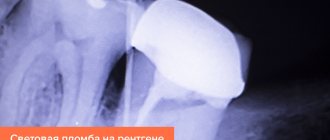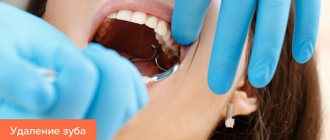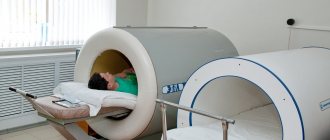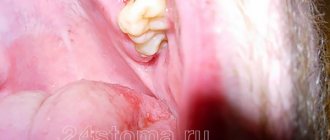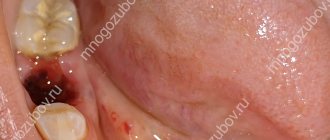Many people have to face the procedure of tooth extraction. Quite often, patients experience discomfort after removal. Unfortunately, eliminating pain does not mean complete recovery. Even if the tooth extraction was performed by an experienced specialist, after such a procedure it is imperative to follow all the doctor’s recommendations. First of all, this applies to full oral care. In addition, you need to monitor your diet. After the tooth extraction procedure, you should definitely check with your doctor how long you need to abstain from eating. Depending on the complexity of the removal, the specialist will suggest a specific time frame.
Why can’t you eat after removal?
This recommendation is due to the fact that very rough food can have a traumatic effect on fresh blood clots that form in the socket after tooth extraction. Clots in the hole are needed to protect the removal site from pieces of food getting into it. If the patient neglects the recommendation regarding how much not to eat after tooth extraction, then food debris may get into the wound. This increases the risk of bleeding and inflammation. Also, failure to comply with this instruction can lead to the development of a cyst, which is a serious complication after tooth extraction. To avoid hunger, experts allow patients to drink liquids, such as drinking yoghurt or kefir. You should eat food after tooth extraction very carefully, and you must follow the time interval recommended by the specialist.
What not to do after tooth extraction
First, avoid mechanical impact on the wound: touching the wound with your tongue, brushing, getting pieces of food, intensive rinsing and creating a vacuum in the mouth. These actions can provoke an inflammatory process. Secondly, control temperature changes. The sudden change from hot to cold also slows down the healing process. Thirdly, avoid excessively heating the wound: increased temperature provokes bleeding.
How to care for your teeth after tooth extraction? Monitor the condition of the socket after surgery, clean your mouth regularly and avoid exposure to negative factors. Consult a doctor at the first signs of inflammation: pain and fever for more than two days, the appearance of pus in the wound and bad breath, itching and swelling. It is important to determine the cause of inflammation as soon as possible and prevent its development.
Hot meals
During the first 24 hours after tooth extraction surgery, you should not eat hot foods. This is due to the fact that increased temperature can cause vasodilation, which in turn will lead to an increase in blood flow. This situation can provoke the development of recurrent bleeding. Because of this, patients are also prohibited from visiting baths and saunas after removal. If a person neglects this prescription and does not think about the question of how long after surgery he can return to his usual diet, then there is a high risk of developing all kinds of complications. Recommendations for nutrition after tooth extraction are in most cases individual and depend on the specific situation. For some, doctors allow them to eat any food without restrictions just a few hours after the procedure. However, most often you need to wait a little longer.
Causes of alveolitis
The main reason for the development of the disease is the patient’s failure to comply with personal oral hygiene. In addition, there are a number of other reasons:
- Chronic gum inflammation;
- The appearance of plaque on the teeth;
- Carious teeth that are located next to the tooth;
- Weak immune system;
- Unremoved tissue in the depths of the hole;
- Eating hard and spicy foods after tooth extraction.
In some cases, the disease can affect the respiratory tract. Do not delay treatment, it is important to us that you remain healthy. Pay attention to the condition of your teeth, because the condition of the entire body depends on them. Make an appointment at our clinic or schedule a consultation with your dentist.
When can you drink
When asking a specialist how long after tooth extraction you can eat, most patients are also interested in the question of taking liquids. There are no contraindications to clean water, and you can drink it immediately after surgery. However, experts do not recommend rinsing the mouth. This is due to the fact that using liquid from the hole can wash out a blood clot, and this can provoke the development of complications. Experts advise drinking only boiled water, which should not be hot.
When to see a doctor
The appearance of the following symptoms is a reason to visit a doctor:
- labored breathing;
- discomfort when swallowing;
- high body temperature;
- formation of pus in or near the hole;
- the swelling increases in size after removal.
Thus, in order to avoid complications after surgery, you need to follow the advice of a specialist and follow his recommendations:
- careful oral hygiene;
- proper nutrition;
- giving up alcohol and smoking;
- lack of physical activity;
- absence of body temperature changes (sauna, bathhouse, swimming pool).
Eating food
The period of time during which you cannot eat after tooth extraction depends on the individual characteristics of the patient and the complexity of the operation performed. Most often, a couple of hours after removal, specialists allow you to eat something liquid. Dairy products, such as yogurt or kefir, are good for this. Thanks to such food, the body will quickly be satisfied, and the site of tooth extraction will not be damaged. During your first meal, you should not eat chips, crackers or deep-fried meat. Such hard food will greatly damage the cavity.
How does dental alveolitis manifest?
After tooth extraction, you may not notice the onset of alveolitis. This disease spreads at a high speed and delay in its treatment leads to inflammation of deep tissues. If after 2 days you begin to feel:
- Discomfort in the tooth socket;
- Pain while eating;
- Unpleasant feelings when opening the mouth;
- Headaches and malaise;
- High temperature;
- Swelling of the gums;
- Putrid odor from the mouth.
If these symptoms occur, you should immediately contact your dentist. If not treated in a timely manner, the area of inflammation takes on a bluish tint and the process of tissue death occurs.
Types of dental alveolitis
Depending on the manifestation of symptoms, there are 3 types of alveolitis:
- Serous alveolitis. It manifests itself as constant aching pain. While eating, the pain intensifies significantly. Lymph nodes and body temperature are normal. This condition lasts a week, after which the acute stage of the disease begins.
- Purulent alveolitis. Due to purulent discharge, intoxication of the body occurs. Malaise and increasing pain appear. The gums and face swell, it becomes difficult to open the mouth.
- Hypertrophic alveolitis. A chronic form of the disease that manifests itself sluggishly. Almost all symptoms are absent. The gums become blue and pus flows out of it. When examined by a doctor, the proliferation of affected tissues is diagnosed.
After difficult removal
Such removal is carried out when the dental roots are incorrectly located, on unerupted dental units or in the absence of the crown part of the tooth. Also, more complex surgical procedures may be required if the wisdom tooth is located too far away or a cyst has formed next to it. Late erupted wisdom teeth most often create many problems. Basically they grow incorrectly. The formation of a cyst is a bubble filled with cells and bacteria. And if the cyst is not removed on time, this can lead to the development of serious consequences. After such manipulations, sutures are placed at the removal site. The healing period of the gums after complex tooth extraction may vary in each specific case. If the specialist has not stated, then you should definitely clarify how long after the procedure you can start eating. It is also necessary to take into account the fact that when stitches are applied, they will have to be removed after some time. But with sutures, the socket is more reliably protected. However, even in this situation, you should refrain from eating hot, salty or spicy foods immediately after the removal procedure.
Recommendations after tooth extraction
- Stopping the bleeding. Immediately after the procedure, the empty socket will bleed. This is normal for the first 30-60 minutes. A blood clot should then form on the surface of the wound. At the end of the procedure, the doctor places a tampon on the empty hole to heal it and stop the bleeding. Keep the tampon in place for at least 20 minutes. If the bleeding does not stop, increase this time to 40-50 minutes. You can’t just leave a tampon in place: bacteria will begin to accumulate under it. If the bleeding does not stop within an hour, consult a doctor. Perhaps there is a fragment of root left in the gum; this option is especially relevant for wisdom teeth.
- Pain relief. When the painkiller wears off, you may experience some discomfort in your mouth. If they keep you from sleeping or are simply uncomfortable, you can take a pain reliever. Which medicine should be used - check with your dentist before or after the procedure, but do not do it on your own! Be sure to follow the instructions on the package: do not exceed the permissible dosage.
- Baths instead of rinses. Do not touch the socket for 24 hours after tooth extraction. Any, even the most harmless intervention can seriously harm. Do not touch the wound with your tongue, avoid rubbing the toothbrush or getting pieces of food into the wound. This will delay the healing process and can cause gum inflammation. After 24 hours, you can begin medicinal baths as recommended by your doctor for the next 3-5 days. Herbal decoctions are suitable for this: chamomile or calendula. You can also use medicines: chlorhexidine, miramistin and others. The essence of the baths is to retain liquid in the mouth for up to 20 seconds. In this case, there is no need to rinse the mouth, otherwise you can wash the blood clot out of the hole.
- Care of the cavity after tooth extraction. Despite surgery, your teeth still need to be cared for and cleaned. During the first 24 hours after tooth extraction, you should refrain from brushing. Next, carry out it no less carefully than before the procedure. It is important to clean the teeth in the vicinity of the empty socket without touching it. Use a soft toothbrush.
- Eating. You can eat and drink within a couple of hours after removal. The food should be soft so as not to damage the wound. Avoid eating nuts, seeds and other similar foods. If possible, avoid chewing with the side on which the tooth was removed.
- Cold compress. Can be used as desired. Cold will reduce the risk of swelling and inflammation, constrict blood vessels and relieve pain. We recommend applying a compress through gauze or a cloth for no more than 20-25 minutes. This is enough to improve your well-being and prevent hypothermia.
- Overheating failure. For three days, avoid hot baths, steam baths or saunas, or prolonged exposure to direct sunlight. Overheating is dangerous due to vasodilation, which can lead to bleeding and the onset of an inflammatory process.
- Abstinence from alcohol and tobacco. It is advisable to give up these habits the day before the procedure and for a couple of days after. This will speed up the healing process. Tobacco can cause bleeding and infection of the socket. Alcohol thins the blood and prevents the wound from healing. When taking antibiotics, you will have to avoid alcoholic beverages for a longer period.
- Refusal of physical activity. We recommend that patients give up sports for at least a day after tooth extraction. The reason is a possible increase in blood pressure, increased blood flow and, as a result, possible bleeding. Exercise and long walks do not fit the restrictions.
- Hole control. Monitor the healing process. If the pain lasts for several days, the wound periodically bleeds, the temperature does not subside, swelling appears, then inflammation is possible. In this case, contact your dentist; do not self-medicate.
What is allowed to eat
One day after the operation, you can eat soft and warm food. It is recommended not to consume fried, spicy and salty foods. This is because such dishes can lead to injury to the socket or irritation of the gums. The temperature of the food consumed should not be high. Recommended drinks to drink:
- dairy products;
- compotes;
- natural juices;
- still mineral water.
It is better to hold off on drinking hot coffee, tea or very cold drinks with ice.
Is it possible to smoke and drink alcohol after wisdom tooth removal?
Smoking after removal of the “eight” is not recommended for 24 hours, as this contributes to the development of a dry socket. You will also have to abstain from alcohol.
The use of modern ultrasound surgery helps speed up recovery after wisdom tooth removal and carry out the intervention as accurately and accurately as possible. Surgeons at the Vilma-Dent clinic use a modern Japanese device, VarioSurg NSK. Make an appointment with a doctor in Moscow: +7 (495) 133-8623
SIGN UP
Soft food
If you answer the question of how long after tooth extraction you can start eating, then you can eat food either on the day of the operation or on the next day. However, it should be remembered that food must be soft at first. In order for the healing period to pass comfortably and quickly, experts recommend consuming soups, liquid cereals, purees, as well as foods enriched with vitamins in the first 2-3 days. The diet should include fruits, but preference should be given only to those with soft flesh. These are peaches, bananas, seedless berries, melon, apricots and persimmons. But it is better to refrain from citrus fruits such as oranges, lemons, kiwi, pomegranate and others. The large amount of acid contained in them has a negative effect on irritated gums.
Eating after removal
1. After the procedure, refrain from eating for at least two hours. In some cases, the doctor recommends not eating for a longer period of time. There are a number of reasons why you should refrain from eating:
- there is a high risk of injury to the socket and re-opening of bleeding;
- the blood clot can be washed out, the hole will be unprotected from germs;
- Chewing food can injure the inflamed gum around the socket of the extracted tooth.
2. On the day of removal, you should not eat hard food; you should chew food on the side of the jaw opposite to the removal. It is best to limit yourself to soft foods that can be swallowed (mashed potatoes, broth). All food should be warm; hot food can cause bleeding.
3. After removal, you need to drink carefully, in small sips, so as not to provoke the washing out of the blood clot. Drinks should also be moderately warm. During the first days, avoid drinking drinks that can irritate the mucous membranes: soda, strong coffee, berry compotes, juices, fruit drinks, lemonade. Plain water and tea are the best drinks after removal.
4. It is also better to avoid salty and spicy foods in the first few days. The same goes for hard fruits and vegetables that can injure your gums. Avoid any hard candies or chewing gum.
Here is an approximate list of products and dishes that will not harm the healing of the socket and do not injure the periodontium:
- soft cottage cheese, yogurt, kefir or milk;
- omelette, porridge, soft cottage cheese casserole;
- pea, mushroom or potato puree soup;
- mashed potatoes.
It is better to exclude cookies and sweets from the diet for several days. You can replace sweets with baby purees and cottage cheese desserts.
Alcoholic drinks can only be drunk ten days after removal. The opinion that ethyl alcohol disinfects is erroneous. Alcohol thins the blood and can cause severe bleeding.
In addition, during the first days you should avoid any physical activity and limit visits to swimming pools, saunas and baths.
How long does pain last after tooth extraction?
During the removal procedure, the tissue that surrounded the tooth is injured and the gums become inflamed. Due to the effect of anesthesia, the patient does not feel pain immediately after removal. But after a couple of hours, pain may occur. Over time, the pain becomes less and less. The duration of pain depends on numerous factors:
- The patient takes medications prescribed by the doctor to speed up healing.
- Complexity of the procedure.
- Strict compliance with all instructions and recommendations of a specialist.
After a complex removal, pain can spread not only to the gums, but also to the cheek, as well as to neighboring teeth. The healing process after such manipulation will take a little longer. Swelling after tooth extraction usually goes away within a couple of days. If, several days after the procedure, swelling and pain do not go away, then this may be a symptom of the development of complications. In such a situation, you must immediately seek the help of a specialist. In our 3D dental clinic "NovaDent" all surgical procedures are performed using high-quality modern anesthesia. The consultation is conducted by experienced, qualified dental surgeons who remove teeth as carefully as possible. We try to create comfortable living conditions for our patients, and do everything possible to minimize the risks of complications after removal. By making an appointment with our dentistry, you will receive a detailed consultation, be able to undergo highly accurate diagnostics, and also receive high-quality dental services using modern equipment using reliable materials. Sign up right now on our website using the registration form or call the administrators, who will be happy to find a convenient appointment time for you - we work seven days a week and weekends. Phone number to make an appointment with our specialists. Trust your health only to professionals!
Treatment of alveolitis
This disease cannot be treated independently, as incorrect treatment methods can cause complications. Therefore, if you suspect tooth inflammation after extraction, you should make an appointment with a dentist. To cure alveolitis you need to:
- Remove all foreign bodies from the socket cavity. The doctor applies anesthesia to the gum and cleans the walls of the socket.
- Placement of an antiseptic drug into the tooth socket.
- Taking antibiotics and painkillers. Depending on the development of alveolitis, the necessary drugs for treatment are selected.
- Application of dental pastes. Used 2 days after the main treatment, it accelerates the healing process and relieves pain.
Many people try to cure inflammation of the socket using antibiotics. But this treatment method is ineffective. Treatment of alveolitis must be carried out comprehensively, and the main measure that only a doctor can take is the removal of pus from the cavity of the socket.

